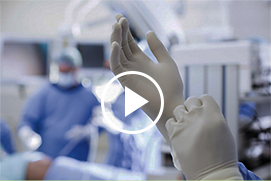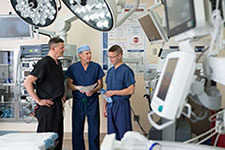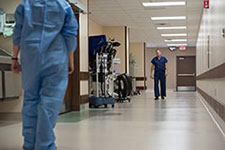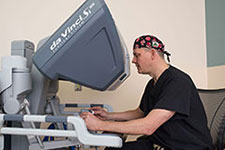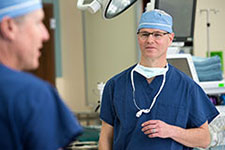What is laparoscopic adjustable gastric banding?
Laparoscopic adjustable gastric banding (LAGB) is one of the least invasive operations available for obesity. It’s done with a few tiny abdominal cuts, instead of with one large cut. The surgeon puts instruments through the cuts. One of those instruments is a laparoscope, a tool with a tiny camera. The surgeon uses these tools to place a band around the top portion of the stomach, leaving a very small pouch available for food. The small pouch means that you feel full after eating only small amounts of food. This will help you lose weight. As its name suggests, the procedure can be adjusted and even reversed.
Why might I need a laparoscopic adjustable gastric banding?
LAGB is used to treat severe obesity, which is linked to high blood pressure, high cholesterol, type 2 diabetes, sleep apnea, and arthritis. It is recommended for people who have tried other weight loss plans without long-term success. Once you lose a significant amount of weight, your risk falls for these weight-related health problems. Adjustable gastric banding may help you live longer if you can’t lose weight in other ways.
Your doctor might recommend LAGB if you are severely obese with a body mass index (BMI) greater than 40. Your doctor might also recommend it if you have a BMI between 35 and 40 and a medical condition such as sleep apnea, high blood pressure, heart disease, or type 2 diabetes.
What are the risks for laparoscopic adjustable gastric banding?
Laparoscopic surgery carries fewer risk factors than open surgery because you don’t need a major cut, or incision. Although complications from surgery are less common with laparoscopic surgery, they could include life-threatening blood clots, bleeding, or infection. The procedure also carries the same risk of any general anesthetic for breathing problems and reactions to medication or anesthesia. Other LAGB complications can include band slippage, puncturing the stomach, or blocking the flow of food through the band.
Food intolerance after gastric band surgery is common. For instance, you might not be able to digest red meat, a major source of dietary iron. This would put you at a higher risk for anemia.
Other complications include severe, life-threatening vitamin and mineral deficiencies such as beriberi (Vitamin B1 deficiency). This is particularly true if you don’t eat a high-protein diet and don’t take you daily supplements as prescribed. But, nutritional deficiencies can occur even if you closely follow the diet and supplements prescribed for you. Your doctor will typically order regular blood tests to watch your levels.
There may be other risks, depending upon your specific medical condition. Be sure to discuss any concerns with your doctor before the procedure.
How do I get ready for laparoscopic adjustable gastric banding?
- Your doctor will make sure that you are a good candidate for LAGB. You should also get surgical clearance from your own health care provider. It is not unusual to have an office visit, blood work to test for nutritional deficiencies and other problems, and an electrocardiogram (ECG) to make sure you have no pre-existing problems.
- Your bariatric surgery center will ask you to enroll in a special pre-surgery program of education about healthy living and about the operation to prepare for the operation. Surgery isn’t recommended for people who are abusing drugs or alcohol, who may have other serious medical problems, or who are not willing to make a commitment to life-long diet and exercise programs.
- If you’re a smoker, you must quit before surgery and should not start again.
What happens during a laparoscopic adjustable gastric banding?
- You will have general anesthesia during the surgery.
- The surgeon will make several small cuts in your abdomen so he or she can put in the necessary surgical instruments.
- A gastric band made of a special rubber material will be put in place around your stomach and then tightened so that the upper part of the stomach forms a small pouch.
- The surgeon will leave a small port under the skin of your stomach. If the size of the pouch needs to be increased or decreased, a doctor can insert a needle into the port and inflate or deflate the band, which works like a balloon, and compresses the channel in the stomach around which the band has been placed.
- LAGB usually takes 30 to 60 minutes.
What happens after laparoscopic adjustable gastric banding?
You will typically be able to go home the day after the procedure. Your diet will be mostly liquids and pureed food for 2 to 3 weeks. You will then slowly begin adding soft foods, then regular foods. You can return to a regular (but smaller) diet after about 6 weeks.
As part of necessary lifestyle changes, you'll need to eat smaller meals. You'll need to chew your food slowly and repeatedly into a liquid slurry before swallowing. You also need to eat a healthy diet high in protein, vitamins, and minerals, and low in sugar.
LAGB does not make you lose weight suddenly. But it is a safer, less invasive procedure than other weight-loss surgery, including traditional gastric bypass. You'll have to be prepared to eat appropriately and exercise. But you can expect long-term weight loss equaling one fourth to one third of your original weight.
Because you'll be at high risk for nutritional deficiencies for the rest of your life, you'll need to take daily supplements as prescribed. You'll also need to have life-long medical care to watch for any nutritional problems.
Next steps
Before you agree to the test or the procedure make sure you know:
- The name of the test or procedure
- The reason you are having the test or procedure
- The risks and benefits of the test or procedure
- When and where you are to have the test or procedure and who will do it
- When and how will you get the results
- How much will you have to pay for the test or procedure



